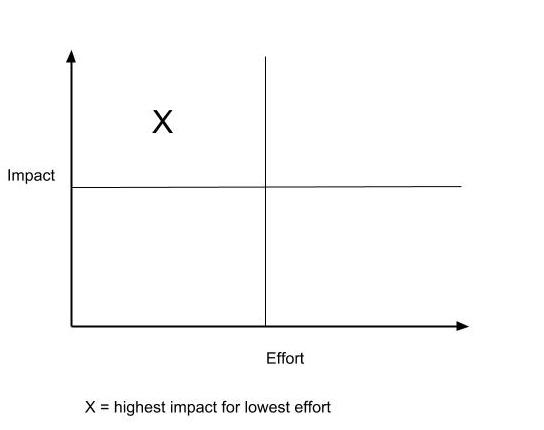The Impact Effort Matrix is one of the tools we use all the time.
The reason for doing it? Just because you explained the priorities and it was really clear in your head, doesn’t mean that it’s really clear in everyone else’s head. People always hear different stuff to what you think you’ve said.
If you do the Impact Effort exercise with your group or team, you’ll all get clearer, and it might shed light on what everyone is working on right now too.

Impact Effort Matrix – How to do it with your team
- Get everyone together and hand out post-it notes
- On a large sheet of paper, draw the Impact-Effort matrix – a grid with four quadrants based on the overlap between effort and impact. Impact runs along the side y axis. The higher up, the more impact. Effort runs along the bottom x axis. The further to the right along this axis, the harder the task or project. (see diagram above).
- Ask everyone to write down on their post-it notes all the projects they’re currently working on, including business-as-usual tasks.
- Then get everyone to place their post-it notes where they believe they should be on the grid.
- Have a group conversation about where they’ve put their projects and work, and whether it’s right.
- You can also discuss which of the quadrants you should all be focussing on.
In this group conversation, everyone will start to see what everyone else is doing. And you’ll be discussing what’s valuable and what isn’t valuable.
That may not always be comfortable, but it will at least become clear to everyone why for example it’s important to make time for some projects and why you need to stop doing others.
At the end, everyone should be clearer about what is important and why, and you will all be clearer about what everyone’s work is.
The tool is simple. The whole point is the conversation.
Here’s a breakdown of how to think about the quadrants and where to prioritise:
Low-Effort-High-Impact (top left)
Here are the tasks and projects that have the biggest impact without much extra work. This is the quadrant you really want people to be spending time on. This is where everybody wins.
High-Impact-High-Effort (top right)
These are the things you usually never get round to doing, because they’re too hard, and there’s so much noise and busyness in between. We suggest you should probably have only a small number of things here, because they require recurrent focus and tend to require long-term effort.
Low-Impact-Low-Effort (bottom left)
Some of this work is unavoidable, but they are the kinds of things you could do when you’re tired, or you might want to batch them, or you might want to push them into the darkest corner of the week if you can’t get rid of them.
Low-Impact-High-Effort (bottom right)
As a group and as an individual in the group, if you’re finding things in the High-Effort-Low-Impact sector, there’s a really important conversation to be had about whether you should be doing this work at all, and what the consequences will be if you stop it. If you can stop them, it might free up the time to focus on the Low-Effort-High-Impact projects.
Here’s a story to illustrate how to use this Impact Effort exercise:
We’ve been working with a group of senior leaders in an organisation. The exercise we did with them started out as a Project Mapping piece where the managers were individually mapping out all the work they were trying to focus on.
They all spent a good 45 minutes with their heads down, just writing things out and trying to sequence their projects and tasks onto cards, to work out what the heck was going on in their world and map it all out. There was just tons and tons of actions and tasks and projects.
It became obvious that they barely had a grasp of their own world, let alone what their peers were doing.
We started to look at how they could cut their workload down and sort it all out because it was all just too overwhelming.
Some of the work could be delegated away, but there wasn’t enough resource in the organisation to delegate all of it.
They had to start choosing between different projects and tasks.
So we applied the Impact Effort matrix.
The initial step was to do the Impact Effort matrix individually, but when we went around the room and started listening to each other, two things happened:
- There was a greater awareness of what everyone else was up to.
- They discovered overlaps and synergies, and context that was missing because there was no mechanism for them to have conversations. Their world was so big and they were so busy managing down, they didn’t have time for horizontal conversations.
This process allowed them to have horizontal conversations, and it turned out that for example, one had information that another needed to know, one had people working on the same thing as another, and a few had conversations about how they had no idea others were doing particular work, and should they really be doing that at all?
This process also made it easier to make decisions about what they could stop doing when their peers echoed their opinion.
They were able to use this exercise to cut their workloads down, get clearer on what they should be spending their time on, and it also helped pull the whole group together.
And in case you think this only works for senior execs, we’ve also done it with team leaders coordinating front line delivery. At this level too it turns out they didn’t have full clarity on what work their colleagues were doing or how they were spending their time.
They had assumptions, but this technique and the conversations around it made everything much clearer and really helped them prioritise together.
Here’s another story to illustrate why conversations around priorities are important.
We’d been working with a group of senior managers in a large non-UK infrastructure organisation.
We’d done the same Project Mapping exercise, and everyone had all their projects and tasks laid out on a table, and the question was, what can you stop doing? ie how do you prioritise?
One manager said, “It’s really hard to know what to prioritise because I get so many missives from my boss about new initiatives, there’s a constant flood of it and I can’t work out what’s important or not.”
We went back to what his job was about. And gave him confidence about how he filters these missives using the Impact Effort matrix.
As we were talking, an email popped into his inbox with an instant request from his boss’s assistant saying, ‘Hey, we’ve just had news that we need to do a full health and safety audit on a particular part of the organisation, can you get this back to me by the end of the week? Thanks.’
It was going to need a ton of work. The manager knew nothing about it beforehand, if he jumped on it, he would derail a whole bunch of other work that he’d already organised.
He was upset.
I asked what would happen if he emailed back and said, “Hey, thanks for your email, I’m not aware of this workstream, I’m totally rammed and I can’t accommodate it at this time.’
He sent it.
Within a minute, an email pinged back, “No worries mate, that’s fine. To be honest, I just got asked for this, I didn’t know who needed to do it, so I pinged it out to you and half a dozen other people, and it really isn’t that high a priority.”
The assistant did not provide any context, didn’t communicate the priority, didn’t know who to send it to, and now all of the other people are primed to do the same piece of work, reallocating resource, with massive duplication, and none of them were questioning it.
You can see why doing this kind of exercise and having these conversations is important.
These tips and strategies come from our Working Smarter programme – if you can find the time and the headspace to do it, it is a brilliant way to change your mindset and learn practical ways to be more productive.
If you’d like to make work better try the manager programme first for yourself, and if you think it’s good, get the team version with or without clinics for your organisation. Contact us here.
